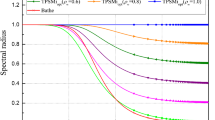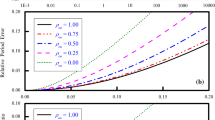Abstract
This paper introduces two new types of precise integration methods based on Chebyshev polynomial of the first kind for dynamic response analysis of structures, namely the integral formula method (IFM) and the homogenized initial system method (HISM). In both methods, nonlinear variable loadings within time intervals are simulated using Chebyshev polynomials of the first kind before a direct integration is performed. Developed on the basis of the integral formula, the recurrence relationship of the integral computation suggested in this paper is combined with the Crout decomposed method to solve linear algebraic equations. In this way, the IFM based on Chebyshev polynomial of the first kind is constructed. Transforming the non-homogenous initial system to the homogeneous dynamic system, and developing a special scheme without dimensional expansion, the HISM based on Chebyshev polynomial of the first kind is able to avoid the matrix inversion operation. The accuracy of the time integration schemes is examined and compared with other commonly used schemes, and it is shown that a greater accuracy as well as less time consuming can be achieved. Two numerical examples are presented to demonstrate the applicability of these new methods.
Similar content being viewed by others
References
Argyris JH, Vaz LE and Willam KJ (1977), “Higher Order Methods for Transient Diffusion Analysis,” Computer Methods in Applied Mechanics and Engineering, 12: 243–278.
Bathe KJ and Wilson EL (1976), Numerical Methods in Finite Element Analysis, Prentice-Hall, Englewood Cliffs, N.J.
Fung TC (1997), “A Precise Time-step Integration Method by Step-response and Impulsive-responses Matrices for Dynamic Problems,” International Journal for Numerical Methods in Engineering, 40: 4501–4527.
Gellert M (1978), “A New Algorithm for Integration of Dynamic Systems,” ComputersandStructures, 9:401–408.
Golley BW (1996), “A Time-stepping Procedure for Structural Dynamics Using Gauss Point Collocation,” International Journal for Numerical Methods in Engineering, 39: 3985–3998.
Gu YX, Chen BS and Zhang HW (2001), “Precise Time-integration Method with Dimension Expanding Method for Structural Dynamic Equations,” AIAA Journal, 39(12): 2394–2399.
Kujawski J and Gallagher R H (1989), “A Generalized Least-squares Family of Algorithms for Transient Dynamic Analysis,” Earthquake Engineering and Structural Dynamics, 18: 539–550.
Lin JH, Shen WP and Williams FW (1995), “A High Precision Direct Integration Scheme for Structures Subjected to Transient Dynamic Loading,” Computer & Structures, 56(1): 113–120.
Riff R and Baruch M (1984), “Time Finite Element Discretization of Hamilton’s Law of Varying Action,” AIAA Journal, 22: 1310–1318.
Rivlin TJ (1990), Chebyshev Polynominals, New York, Wiley.
Tarnow N and Simo JC (1994), “How to Render Second Order Accurate Time Stepping Algorithms Fourth Order Accurate While Retaining the Stability and Conservation Properties,” Computer Methods in Applied Mechanics and Engineering, 115: 233–252.
Wang Mengfu (2006), “An Unconditionally Stable Precise Time Step Integration Method of Structural Dynamic Analysis,” Acta Mechanica Solida Sinica, 27(3): 311–314. (in Chinese)
Wang Mengfu and Au FTK (2006), “Assessment and Improvement of Precise Time Step Integration Method,” Computer & Structures, 84(12): 779–786.
Wang Mengfu and Zhou Xiyuan (2005), “Modified Precise Time Step Integration Method of Structural Dynamic Analysis,” Journal of Earthquake Engineering and Engineering Vibration, 4(2): 287–294.
Wood W L (1990), Practical Time-Stepping Schemes, Clarendon Press, Oxford.
Zhong W X and Williams F W (1994), “A Precise Time Step Integration Method,” Proceedings of Institution of Mechanical Engineers, Part C: Journal of Mechanical Engineering Science, 208: 427–430.
Author information
Authors and Affiliations
Corresponding author
Additional information
Supported by: Human Provincial Natural Science Foundation Under Grant No.02JJY2085
Rights and permissions
About this article
Cite this article
Wang, M., Au, F.T.K. Precise integration methods based on the Chebyshev polynomial of the first kind. Earthq. Eng. Eng. Vib. 7, 207–216 (2008). https://doi.org/10.1007/s11803-008-0837-4
Received:
Accepted:
Published:
Issue Date:
DOI: https://doi.org/10.1007/s11803-008-0837-4




